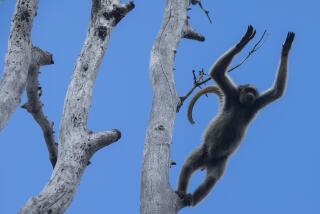Orangutan Gets a Helpful Prescription
- Share via
WASHINGTON — Tucker the orangutan had a bad cough. A really bad cough.
But orangutan cough medicine wasn’t working on the shaggy 233-pound resident of the National Zoo. The antibiotic also tasted horrible, and Tucker wasn’t fooled when the nasty stuff was stirred into coffee, peanut butter or Jell-O.
He moped. The cough got worse. His lungs filled. He didn’t go out to play much anymore. He was near death.
That’s when the veterinarians called in the physicians. Together the ape doctors and the people doctors devised a treatment regimen that made evolution seem like a shorter trip than even Charles Darwin imagined.
Tucker learned to puff on one of those big inhalers that physicians sometimes prescribe for asthma patients.
Basically, for 20 minutes a day, Tucker aped a wheezing human seeking relief. And soon he was feeling better.
His friends at the zoo weren’t surprised. After all, primate medicine is primate medicine.
“You’re looking at an animal that is genetically 2% or 3% different [from a human] in DNA,” said Lisa Stevens, curator of the ape house. “We are 97% orangutan.”
Relief has replaced alarm at the zoo these days as Tucker appears completely recovered from what had been a life-threatening case of pneumonia last spring.
“He’s doing well,” said Lucy H. Spelman, associate veterinarian at the zoo. “He has days where he coughs a bit, and we worry about him, but he’s acting very well.”
The novel therapy may help in treating future respiratory ailments among the zoo’s eight orangutans, and other zoos may learn from the experience as well, Spelman said.
Meanwhile, at Georgetown University Medical Center, Anne E. O’Donnell, an associate professor of pulmonary medicine, has found a new application for her expertise. “This is definitely something new,” she said. “It is amazing to see them treated like humans.”
Tucker, a 14-year-old young adult, has long endured chronic bronchitis or some inflammation of his airways. But about a year ago, the condition worsened into pneumonia, or inflammation and clogging of his lungs.
The standard treatment is an oral antibiotic. When that proved ineffective, the zoo was running out of options. By last March, Tucker was seriously ill.
O’Donnell suggested a new antibiotic and administering it via a device called a nebulizer.
The contraption of plastic tubes attached to a compressor powered by electricity is designed to transform liquid into mist that can be inhaled. It is commonly used to administer asthma medicine to people, but it is not to be confused with the little portable inhalers that some people carry to relieve breathing problems.
Using a nebulizer to administer antibiotics is less common, and it is rarer still to give a nebulizer to an orangutan, though other zoos have experimented with the technique.
The next question was how to persuade Tucker of the wisdom of this solution. It took about a week. “We’re working with an animal that is intelligent and sociable, and it wasn’t very difficult,” Stevens said. “I wasn’t surprised that he learned it so quickly.”
The men and women who work with the animals already have a daily relationship with them. They would put the nebulizer tube through the cage to Tucker’s mouth. When he inhaled properly, he was rewarded with a squirt of apple juice or pineapple juice. Even if he inhaled from the tube through his nose, he was rewarded.
Tucker drew medicine from the nebulizer twice a day for 10 minutes each session, and after a month, by early September, his pneumonia had cleared up.
More to Read
Sign up for Essential California
The most important California stories and recommendations in your inbox every morning.
You may occasionally receive promotional content from the Los Angeles Times.













